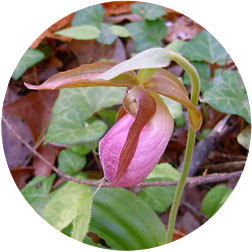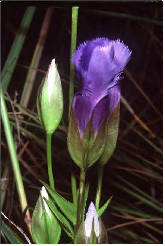Plant Portrait
Scientific Name: |
Gentianopsis crinita |
|---|---|
Common Name: |
Fringed Gentian |
Native/Alien: |
Native |
Type: |
Annual / Biennial |
Bloom Time: |
September and early October |
State Status: |
Endangered (*) |
|
Buds
© Robert H. Mohlenbrock. USDA SCS. 1989.
|
|
Notes: |
Misty Franklin, with the NC Natural Heritage Program, writes about Fringed Gentain (2004):
One of the rarest plant species in North Carolina is the lovely fringed gentian (Gentianopsis crinita). This gorgeous plant is listed as Endangered and of Special Concern by the state of North Carolina, but despite recent studies of habitat and range, very little is known about the life history of the species. This plant is so beloved by those who have worked with it that when part of a population in NC was recently threatened by a road-paving project, volunteers jumped at the chance to rescue the imperiled plants. This opportunity to work with the species gave me a chance to review what is currently known about fringed gentian and look ahead to questions that still need answers. Fringed gentian is reported to be a biennial by some researchers and an annual by others. However, all who work with the species agree on the beauty of the striking deep purple or blue flowers. The 4 corolla lobes have finely fringed margins. Before opening, the flowers are wrapped and twisted into a showy bud, and upon opening, the petals spread almost horizontally. Plants bloom in September and early October. The species grows in open habitat where the predominant vegetation consists of tall herbs and low woody shrubs. It does not appear to compete well and does not survive among tall shrubs. Preliminary studies in New York indicated the species lacks a persistent seed bank, so preserving live individuals in populations is especially important. According to studies conducted by Jane Robertson at Cornell University and Kay Campany at Appalachian State University, throughout its range, the species appears to be restricted to circumneutral soils, in sites with reduced competition from other plants. This combination of site conditions is rare in North Carolina, so it is no wonder the species is rare here. According to Robertson's research, fringed gentian would have been ideally suited to conditions that were probably widespread in the late-glacial period in eastern North America. After ice retreated in New England approximately 18,000 years ago and before forest cover developed around 12,000 years ago, vegetation was characterized by bryophytes, herbs, and low shrubs. Robertson hypothesizes that substrates would have been very unstable in a zone along the ice margin. Widespread frost heaving in saturated soils would have made unleached mineral substrates that were relatively high in bases, including calcium, relatively common. The flora during the late glacial period in eastern North America appears to have been dominated by light-demanding, herbaceous species that grow on calcareous (circumneutral) substrates, and Gentianopsis is known to have been present. The current range of fringed gentian is largely within the part of North America that was once glaciated (except for a narrow band along the Appalachian mountains). In the time since the forests have dominated eastern North America, suitable habitat for fringed gentians appears to be largely restricted to the few areas that have maintained open, calcareous habitat, including unstable river banks, marl marshes, beaver meadows, fragments of prairie, and through human disturbance, old fields, roadsides, and mines. Fringed gentian is historically known from 26 states from the southern Appalachians to New England and west to North Dakota, but is threatened, endangered, special concern, or extinct in all but 7 of those states. Although it has no federal conservation status, the species is listed endangered by the states of NC, GA, VA, MD, RI, NH, and ND. The three occurrences in NC are in the mountains (Ashe, Clay, and Watauga counties). Two of the occurrences receive some form of protection from the Nature Conservancy and US Forest Service. The third population occurs along an unprotected roadside. In NC and elsewhere across its range, this species appears to be declining. Fringed gentian in NC is threatened by invasion of habitat by woody shrubs, wetland drainage, and the alterations in natural soil disturbances that would keep substrate open for seed germination. When biologists from the NC Department of Transportation (NC DOT) recently alerted me to a road project in the vicinity of a fringed gentian population, I got together with Peter Smith (NC Natural Heritage Program), Mike Sanderson and Jay Mays from NC DOT, Gary Walker, Zack Murrell, and Kay Campany from Appalachian State University (ASU), and Lee Echols, a local volunteer, to find a way to rescue the imperiled plants. Though the road-paving project had not yet begun at press time, NC DOT plans to avoid the bulk of the population. In the meantime, we have stitched together a tentative plan to remove any plants in the impact area to a nearby nature preserve, where the rescued plants can be protected and studied. With luck, this road paving project could prove to benefit the species in NC - the transplant and monitoring will move plants away from vulnerable roadside habitat and at the same time give researchers at ASU an opportunity to learn more about the site requirements and life history of the species. Information learned in this endeavor could eventually be used to help manage and protect the other known populations, and keep this species a part of the rich flora of North Carolina. |
Links: |
USDA PLANTS Database Record |

